

The Chemistry of Dienes and Polyenes. Volume 2
Edited by Zvi Rappoport
Copyright 2000 John Wiley & Sons, Ltd.
ISBN: 0-471-72054-2
CHAPTER 6
Cycloaddition to give heterocycles
GERHARD V. BOYD
Department of Organic Chemistry, The Hebrew University of Jerusalem, Jerusalem 91904, Israel
I. INTRODUCTION . . . . . . . . . . . . . . . . . . . . . . . . . . . . . . . . . . . . . |
481 |
II. ADDITION TO CARBONYL COMPOUNDS . . . . . . . . . . . . . . . . . . |
482 |
III. ADDITION TO CDS COMPOUNDS . . . . . . . . . . . . . . . . . . . . . . . . |
490 |
IV. ADDITION TO IMINES AND CYANIDES . . . . . . . . . . . . . . . . . . . . |
497 |
V. ADDITION TO CDP and CDAs COMPOUNDS . . . . . . . . . . . . . . . . |
511 |
VI. ADDITION TO OXYGEN . . . . . . . . . . . . . . . . . . . . . . . . . . . . . . . |
512 |
VII. ADDITION TO A SDO COMPOUND . . . . . . . . . . . . . . . . . . . . . . . |
514 |
VIII. ADDITION TO NITROSO COMPOUNDS . . . . . . . . . . . . . . . . . . . . |
514 |
IX. ADDITION TO SDN COMPOUNDS . . . . . . . . . . . . . . . . . . . . . . . . |
526 |
X. ADDITION TO AZO COMPOUNDS . . . . . . . . . . . . . . . . . . . . . . . . |
529 |
XI. FORMATION OF FIVE-MEMBERED RINGS . . . . . . . . . . . . . . . . . . |
538 |
XII. REFERENCES . . . . . . . . . . . . . . . . . . . . . . . . . . . . . . . . . . . . . . . |
540 |
|
|
I. INTRODUCTION
The formation of heterocycles by cycloaddition reactions of conjugated dienes is the subject of this chapter. Almost the entire account is devoted to the Diels –Alder reaction of dienes with heterodienophiles to yield six-membered ring compounds (equation 1). Many such reactions have been reported and there is a plethora of reviews. Some1a – p are general; others are cited at appropriate places in the text. This account is highly selective, concentrating on recent work with particular regard to the stereochemistry of these processes.
+ |
X |
|
|
X |
|||
|
|
|
|
|
|||
|
|
|
|
|
|
(1) |
|
Y |
|
||||||
|
|
|
Y |
||||
|
|
|
|||||
|
|
|
|
|
|
||
Some addition reactions leading to five-membered ring compounds are described at the end.
481
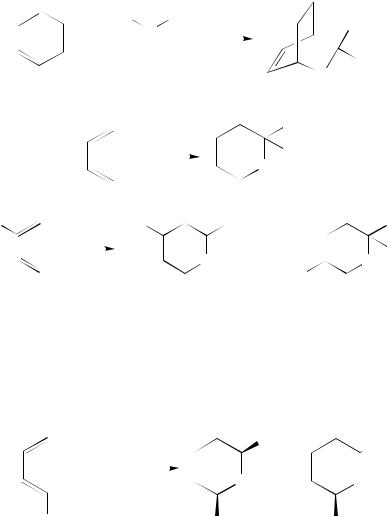
482 |
Gerhard V. Boyd |
II. ADDITION TO CARBONYL COMPOUNDS
Dienes do not react with carbonyl compounds unless the latter are activated by electronwithdrawing substituents such as carboxyl groups. Cyclohexa-1,3-diene, for example, adds diethyl mesoxalate (1) at 120 °C to form 2 (equation 2)2. Other cycloadditions of this ester with various dienes, which were carried out in a sealed tube at 130–135 °C, are shown in equations 3 and 43. It is noteworthy that no product was isolated from the action of diethyl mesoxalate on cyclopentadiene; it was suggested3 that the cycloadduct reverted to its components at the high temperature required for the reaction.
|
|
EtO2C |
|
|
|
CO2Et |
|
|
|
CO2Et |
||
|
+ |
|
|
C |
|
|
|
|||||
|
|
|
|
|
|
|
|
|
|
(2) |
||
|
|
|
|
|
|
|
|
|
|
|
||
|
|
|
|
O |
|
|
||||||
|
|
|
|
|
|
|
CO2Et |
|||||
|
|
|
|
|
|
|
|
|
|
|
|
|
|
|
|
|
|
|
|
|
|
|
|
O |
|
|
|
|
|
(1) |
|
|
|
|
(2) |
|||
|
|
|
|
|
|
|
|
|
|
CO2Et |
|
|
|
+ |
1 |
|
|
|
|
CO2Et |
(3) |
||||
|
|
|
|
|
||||||||
|
|
|
|
|
||||||||
|
|
|
|
|
|
|
|
|
|
O |
||
|
|
|
|
|
|
|
|
|
|
|||
|
|
|
|
|
|
|
|
|
|
|
|
|
|
|
|
|
|
|
|
|
|
78% |
|
|
|
Me |
|
|
Me |
CO2Et |
|
CO2Et |
||||||
+ |
1 |
|
|
|
|
|
|
O |
CO2Et + |
|
CO2Et |
|
|
|
|
|
|
|
|
||||||
|
|
|
|
|
|
|||||||
|
|
|
|
|
|
|
|
|
|
|
O |
|
|
|
|
|
|
|
|
|
|
|
Me |
(4) |
|
|
|
|
|
80% |
|
|
7% |
|||||
The presence of electron-donating substituents in the diene enables it to react with simple aldehydes: thus both acetaldehyde and benzaldehyde add to 1-methoxy-1,3-butadiene at 50–65 °C under high pressure (20 Kbar) to give dihydropyrans as 70 : 30 mixtures of cis- and trans-isomers (equation 5)4. The combination of electron-rich diene/electron-poor dienophile makes it possible to perform the reaction under milder conditions. 2-Alkyl-1- ethoxy-1,3-butadienes and diethyl mesoxalate afford dihydropyrans almost quantitatively (equation 6)5.
|
|
|
|
R |
|
|
|
R |
+ |
RCHO |
|
|
|
+ |
|
|
|
|
|
|
|
|
|
|||
|
||||||||
|
|
|
|
O |
|
|
O |
|
|
|
|
|
|
||||
|
|
|
|
|
(5) |
|||
OMe |
|
|
|
OMe |
|
|
OMe |
|
|
|
|
|
R = Me or Ph |
|
|
|
|

|
6. Cycloaddition to give heterocycles |
483 |
||||
|
|
|
|
|
CO2Et |
|
|
|
+ 1 |
|
|
|
CO2Et |
|
|
|
|
|
||
|
|
|
|
|
||
R |
|
|
|
|
O |
(6) |
|
|
|
|
|||
|
|
|
|
|
||
|
|
|
R |
|
||
|
|
|
|
|
||
|
OEt |
|
|
|
OEt |
|
|
|
|
|
|
|
|
An outstandingly reactive diene is 1-methoxy-3-(trimethylsilyloxy)-1,3-butadiene (‘Danishefsky’s diene’) 4, prepared by the action of trimethylsilyl chloride on the ketone 3 in the presence of zinc chloride/triethylamine (equation 7)6. The reaction of diethyl mesoxalate with Danishefsky’s diene gives the dihydropyran 5; with the (trimethylsilyloxy)dienes 6 and 7, mixtures of dihydropyrans are obtained, in which the ‘meta-isomers’ predominate (equations 8 and 9)7.
O |
|
|
Me3SiO |
|
|||
+ Me3SiCl |
|
|
|
(7) |
|||
|
|||||||
|
|
|
|
|
|
|
|
OMe |
|
|
|
|
OMe |
||
(3) |
|
|
(4) |
|
|||
Me3SiO |
|
|
CO2Et |
|
|||
|
|
|
|
|
CO2Et |
|
|
|
|
|
|
|
|
||
|
|
|
|
O |
|
||
|
|
|
|
|
|||
|
|
|
OMe |
|
|||
|
|
|
(5) |
|
|
|
|
Me |
|
|
|
|
CO2Et |
||
Me3SiO |
|
|
|
|
CO2Et |
||
|
|
|
|
||||
1 |
|
Me3SiO |
O |
||||
|
|
|
|
||||
|
|
|
|
|
|
Me |
|
(6) |
|
|
|
|
|
'meta-' |
|
|
|
|
+ |
(8) |
|||
|
|
|
|
|
|
Me |
|
|
|
|
Me3SiO |
CO2Et |
|||
|
|
|
|
|
|
|
CO2Et |
|
|
|
|
|
|
|
|
|
|
|
|
|
|
|
O |
|
|
|
|
|
|
|
|
'para-'
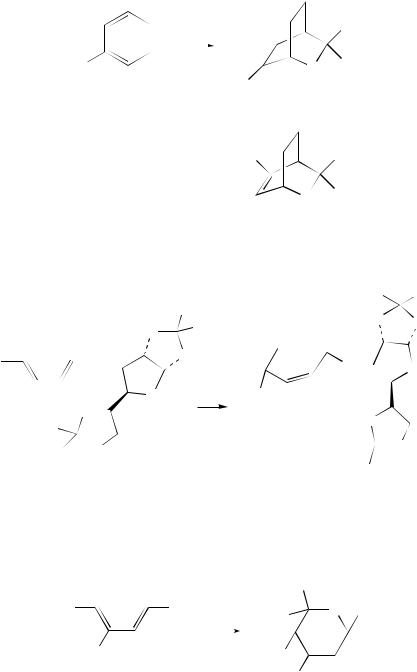
484 |
Gerhard V. Boyd |
|
||
|
1 |
|
CO2Et |
|
|
|
|
||
Me3SiO |
|
|
O |
CO2Et |
|
|
|||
(7) |
|
|
Me3SiO |
|
|
|
'meta-' |
(9) |
|
|
+ |
|||
|
|
|||
|
|
|
Me3SiO |
CO2Et |
|
|
|
O |
CO2Et |
|
|
|
'para-' |
|
Equation 10 shows an example of the synthesis of a chiral functionalized hexapyranoside from diethyl mesoxalate and the butadienyl ether of a protected sugar8a,b.
Me
|
|
|
O |
Me |
|
|
|
|
|
Cl |
|
O |
|
O |
|
O |
1 |
||
|
|
|
||
|
O |
|
||
|
|
|
||
Me |
|
|
|
|
Me |
|
O |
|
|
|
Me |
Me |
CO2Et |
O |
O |
|
EtO2C  O
O
O O
O
Cl
(10)
O
Me O
O
Me
Other carbohydrate syntheses include the formation of dihydropyrans from diethyl mesoxalate and 1-methoxybutadienes (e.g. equation 11)9. The butadiene 8, which is activated by the presence of two alkoxycarbonylamino groups, adds to diethyl mesoxalate in DMF during 44 h at 180 °C in an autoclave to give the cycloadduct 9 in 34% yield (equation 12)10.
|
|
|
EtO2C |
|||
EtO2C |
OMe |
|
EtO2C |
|
O OMe |
|
|
|
1 |
|
|
|
|
|
|
|
(11) |
|||
|
CH2OMe |
|
EtO2C |
|||
|
|
|||||
|
|
|
|
|
||
|
|
CH2OMe |
||||
|
|
|
|
|||
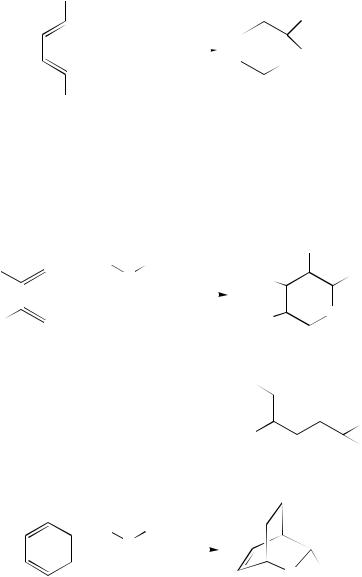
6. Cycloaddition to give heterocycles |
485 |
||||
NHCO2Et |
|
|
|
NHCO2Et |
|
|
|
|
|
CO2Et |
|
+ |
1 |
|
|
CO2Et |
(12) |
|
|
||||
|
|
||||
NHCO2Et |
|
|
|
O |
|
|
|
|
NHCO2Et |
|
|
(8) |
|
(9) |
|
||
In recent years, much work has been done on catalyzed and asymmetric cycloaddition reactions. In the presence of 5 mol% bismuth trichloride, the simple dienes 10 (R1 D R2 D H; R1 D H, R2 D Me; or R1 D Me, R2 D H) react with diethyl mesoxalate to afford mixtures of the cycloadducts 11 and the products 12 of an ene-reaction (equation 13)11,12. 1,3-Cyclohexadiene and ethyl glyoxylate give solely the endo adduct 13 in 50% yield (equation 14)12.
|
R1 |
|
|
|
|
|
|
|
|
|
|
|
|
R1 |
R2 |
EtO2C |
C |
CO2Et |
|
|
|
|
|
CO2Et |
|||||
|
|
|
|
|
R |
2 |
|
|
|
|
||||
|
+ |
|
|
|
|
|
|
|
|
|
|
|
CO2Et |
|
|
|
|
|
|
|
|
|
|
|
|
|
|
||
|
O |
|
|
|
|
|
|
|
|
|
|
|||
|
|
|
|
|
|
|
|
|
|
|
|
|||
|
|
|
|
|
|
|
|
|
|
|
|
|
|
O |
H3C |
|
|
|
|
|
|
|
H3C |
||||||
|
|
|
|
|
|
|
|
|
|
|||||
|
(10) |
|
|
|
|
|
|
|
|
|
|
(11) |
||
|
|
|
|
|
|
|
|
|
|
|
|
(13) |
||
|
|
|
|
|
|
|
|
R1 |
|
|
|
+ |
||
|
|
|
|
|
|
|
|
|
|
|
|
|
|
|
|
|
|
|
|
|
|
|
R2 |
|
|
|
|
|
CO2Et |
|
|
|
|
|
|
|
|
|
|
|
|
|
||
|
|
|
|
|
|
|
|
|
|
|
|
|
||
|
|
|
|
|
|
|
|
|
|
|
|
|
CO2Et |
|
|
|
|
|
|
|
|
|
|
|
|
|
|
||
|
|
|
|
|
|
|
|
|
|
|
|
|
|
|
|
|
|
|
|
|
|
|
|
|
|
|
|
|
OH |
|
|
|
|
|
|
|
|
|
|
|
|
|
||
|
|
|
|
|
|
|
|
|
|
|
|
(12) |
||
|
H |
C |
CO2Et |
|
|
|
|
|
H |
|||||
|
+ |
|
|
|
|
|
|
|
|
(14) |
||||
|
|
|
|
|
|
|
|
|
|
|
||||
|
|
|
|
|
|
|
|
|
|
|
|
|
|
|
|
|
O |
|
|
|
|
|
|
O |
|
|
CO2Et |
||
|
|
|
|
|
|
|
|
|
(13) |
|
|
|
|
|
The first report of a cycloaddition reaction in the presence of an optically active catalyst13 appeared in 198314a. The dienes 14 add to benzaldehyde in the presence of 1 mol% of the chiral lanthanide NMR shift reagent Eu (hfc)3, i.e. tris[3-(heptafluoropropyl- hydroxymethylene)-(C)-camphorato]-europium(III), to give, after treatment with trifluoroacetic acid, the dihydro- -pyrone 15 enriched in the (R)-enantiomer, the degree of
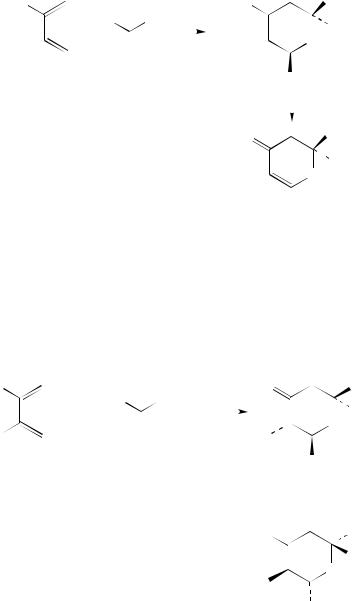
486 |
Gerhard V. Boyd |
asymmetric induction depending on the nature of the group R (equation 15)14.
Me3SiO |
|
|
|
|
Me3SiO |
Ph |
|||
|
|
|
|
|
|||||
H |
|
|
Ph |
|
|
|
|
||
|
|
||||||||
+ |
|
|
|
|
|
|
|
|
H |
|
|
|
|
|
|
|
|
|
O |
|
O |
|
|||||||
OR |
|
|
|
|
|
|
OR |
|
|
(14) |
|
|
|
|
|
|
|
TFA |
|
|
|
|
|
|
|
|
|||
|
|
|
|
|
|
|
|
||
|
|
|
|
|
|
|
|
|
(15) |
|
|
|
|
|
O |
Ph |
|||
|
|
|
|
|
|
||||
|
|
|
|
|
|
|
|
|
H |
|
|
|
|
|
|
|
|
|
O |
|
(15) |
|
|||||||
|
|
|
|
|
For R = Me |
: 18% ee |
|||
|
|
|
|
|
For R = i-Pr |
: 28% ee |
|||
|
|
|
|
|
For R = t-Bu : 38% ee |
||||
The 1,3-butadiene 16, which contains the chiral auxiliary l-menthyl group, reacts with benzaldehyde in the presence of Eu(hfc)3 to yield a mixture of the diastereomeric products 17 and 18 (equation 16); the butadiene 19 similarly affords a mixture of 20 and 21 (equation 17). It is seen that for the combination l-menthyl auxiliary/chiral catalyst the facial selectivity is much higher than for the combination d-menthyl auxiliary/chiral catalyst, which points to an ‘interactivity’ between the chiral auxiliary and the chiral catalyst14.
MeSiO |
|
|
|
|
|
O |
Ph |
||
|
|
H |
|
|
|
Ph |
(i) Eu(hfc)3 |
H |
|
|
|
|
|
|
|
|
|||
+ |
|
|
|
|
|
|
|||
|
|
|
|
(ii) Et3N/MeOH |
|||||
|
|
|
|
O |
|||||
|
|
|
|
|
|
|
|
|
|
Me |
|
|
O |
|
|
Me |
|
||
|
|
|
|||||||
|
|
|
|
|
|
|
|
O−menthyl-l |
|
O−menthyl-l |
|
|
|
|
|
||||
(16) |
|
|
|
|
(17) |
|
|||
|
|
|
|
|
|
|
|
8 parts |
|
|
|
|
|
|
|
|
+ |
(16) |
|
|
|
|
|
|
|
|
|
O |
Ph |
H
O
Me
O−menthyl-l
(18)
92 parts
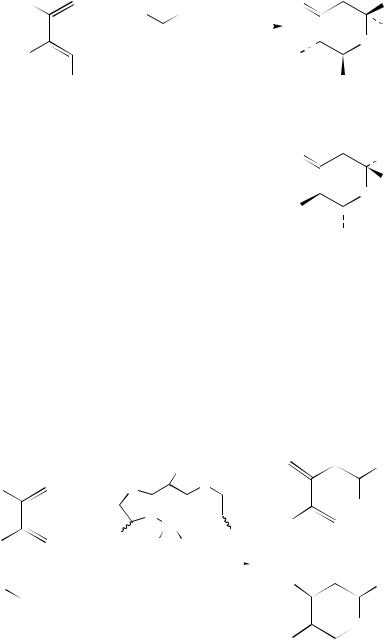
6. Cycloaddition to give heterocycles |
|
487 |
||||||
MeSiO |
|
|
|
Ph |
|
O |
|
Ph |
H |
|
|
|
(i) Eu(hfc)3 |
|
|
|
|
|
|
|
|
|
|
H |
||
+ |
|
|
|
|
(ii) Et3N/MeOH |
O |
||
Me |
O |
|
|
Me |
|
|||
|
|
|
|
|||||
|
|
|
|
|
|
|
||
O−menthyl-d |
|
|
|
|
|
|
O−menthyl-d |
|
(19) |
|
|
|
|
|
|
(20) |
|
|
|
|
|
|
|
|
41 parts |
|
|
|
|
|
|
|
|
+ |
(17) |
|
|
|
|
|
|
O |
|
Ph |
H
O
Me
O−menthyl-d
(21)
59 parts
The chiral copper(II) bisoxazoline compounds 22 (R1 thanesulfonyl) catalyze the enantioselective reactions of
D t-Bu or Ph, Tf D trifluorome- 2,3-dimethylbuta-1,3-diene with
glyoxylic esters HCO2R2 (R2 D Me, Et or i-Pr) to yield mixtures of Diels–Alder and ene products, 23 and 24, the proportions of which depend on the structure of the chiral ligand, the nature of R2 and the temperature of the reaction (equation 18). Thus, ethyl glyoxylate and the diene in the presence of (R)-22 (R1 D Ph) at 30 °C gave the (S)- dihydropyran 23 (R2 D Et (13%) in 85% enantiomeric excess (ee), together with 7% of the ene-product 24 (R2 D Et)15. Treating 1,3-cyclohexadiene with ethyl glyoxylate in the presence of 5 mol% (S)-22 (R1 D t-Bu) in nitromethane led to the smooth formation of the cycloadduct 25 in 66% yield and 97% ee16.
|
|
|
|
|
Me |
Me |
|
|
|
|
CO2R2 |
||
Me |
|
|
|
|
O |
|
|
O |
|
|
|||
|
|
|
|
|
|
|
|
|
|
|
|
|
OH |
|
|
|
|
|
N |
N |
|
|
Me |
|
|||
|
|
|
|
|
|
|
|
|
|||||
|
|
|
|
|
|
|
|
||||||
|
|
|
|
|
|
Cu |
|
|
|
|
|
|
|
Me |
|
|
|
|
R1 |
|
|
|
R1 |
(24) |
|
||
|
|
|
|
Tf |
Tf |
|
|
|
|
||||
|
+ |
(22) |
|
|
|
|
+ |
(18) |
|||||
|
|
|
|
|
|
|
|
|
|||||
|
|
|
|
|
|
|
|
|
|||||
H |
|
|
|
CO2R2 |
|
|
|
|
Me |
|
CO2R2 |
||
|
|
|
|
|
|
|
|
|
|
|
|
O |
|
|
|
|
|
|
|
|
|
|
|
|
|
|
|
|
O |
|
|
|
|
|
|
|
Me |
|
|||
|
|
|
|
|
|
|
|
|
|
|
|
|
|
|
|
|
|
|
|
|
|
|
|
|
|
(23) |
|
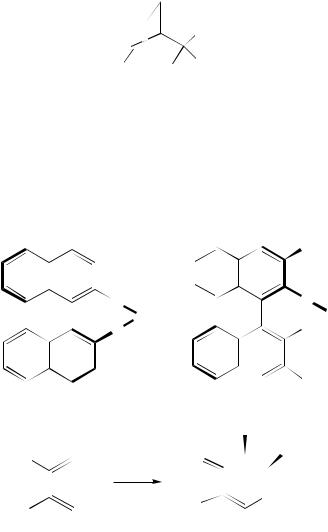
488 |
Gerhard V. Boyd |
H

 O CO2Et
O CO2Et
(25)
Under the influence of 20 mol% of the chiral aluminum complex (S)-26, 2,3-dimethyl- 1,3-butadiene adds to ethyl glyoxylate in dichloromethane at 78 °C to room temperature during 20 h to produce a mixture of the cycloadduct 23 (R2 D Et) (73% yield, 97% ee) and the ene product 24 (R2 D Et) (9% yield, 88% ee)17. The analogous aluminum complexes (R)-27 and (S)-27 (Ar D Ph or 3,5-xylyl) (10 mol% in toluene) catalyze the Diels–Alder reaction of benzaldehyde with the diene 28 to give, after the addition of trifluoroacetic acid, the dihydropyrone 29 in 95% ee, accompanied by a small amount of the corresponding trans-isomer (equation 19)18.
|
|
|
SiAr3 |
|
|
O |
|
O |
|
|
|
|
||
|
AlMe |
|
AlMe |
|
|
O |
|
O |
|
|
|
|
SiAr3 |
|
|
|
|
|
|
|
|
|
|
|
(S)-(26) |
(R)-(27) |
(19) |
||
|
Me |
Me |
|
|
Me3SiO |
|
Ph |
|
|
O |
|
|||
|
PhCHO |
|
|
|
77% |
|
O |
|
|
|
|
|
|
|
Me |
Me |
|
||
(29) |
|
|||
|
|
|
||
|
OMe |
|
|
|
(28) |
|
|
|
|
Benzaldehyde reacts with the diene 28 in |
the presence of 20 mol% of the |
chiral |
||
boric acids 30 (R D n-Bu, Ph or 2-MeOC6H4), obtained from alkylboric acids and the |
||||||
appropriate derivatives of tartaric |
acid, at |
|
78 ° |
C for 4–9 h to afford the |
cis |
-products |
19,20 |
|
|
||||
29 in 56 –95% yields and 87–97% ee |
. Benzaldehyde, cinnamaldehyde and various |
|||||
aliphatic aldehydes (n-hexanal, n-heptanal etc) add directly to Danishefsky’s diene 4 in ether at 30 °C in the presence of the (R,R)-salen chromium complexes 31 (X D Cl, N3, F
or BF4) and 4 A˚ molecular sieves to afford the cycloadducts 32 (e.g. R D Ph, PhCHDCH) in 70 –93% ee21.
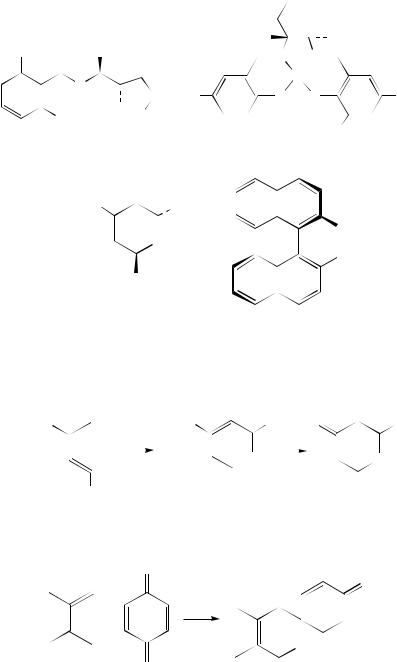
|
|
|
|
|
6. Cycloaddition to give heterocycles |
|
489 |
||||||||||||
|
|
|
|
|
|
|
|
|
|
|
H |
|
H |
||||||
OPr-i O |
CO2H O |
|
|
|
|
|
N |
N |
|
|
|
|
|||||||
|
|
|
|
|
|
|
|
|
|
|
|
|
|||||||
|
|
|
O |
|
|
|
O |
t-Bu |
|
|
|
|
Cr |
|
|
|
|
Bu-t |
|
|
|
|
|
|
|
|
|
|
|
||||||||||
|
|
|
|
|
|
|
|
|
|
|
|
|
|
|
|
||||
|
|
|
|
|
|
|
|
|
|
|
|
|
|
|
|
||||
|
|
|
|
|
|
|
|
|
|
|
|
|
|
||||||
|
|
|
|
O |
|
|
|
|
|
O X |
O |
|
|
|
|||||
|
OPr-i |
B |
|
|
|
|
|
|
|
|
|
|
|
|
|||||
|
|
|
|
|
t-Bu |
|
t-Bu |
||||||||||||
|
|
|
|
|
|
|
|
||||||||||||
|
|
|
|
|
|
|
|
|
|
|
|||||||||
|
|
|
|
|
|
R |
|
|
|||||||||||
(30) |
|
|
|
(31) |
|
|
|
|
|
||||||||||
|
|
|
|
|
|
|
|
|
|
||||||||||
|
|
|
Me3SiO |
|
|
R |
|
|
|
|
|
|
|
|
|
|
|
||
|
|
|
|
|
|
|
|
|
|
|
|
|
|
|
|
||||
|
|
|
|
|
|
|
O |
|
|
|
|
|
|
|
|
|
OH |
||
|
|
|
|
|
|
|
|
|
|
|
|
|
|
|
|
||||
|
|
|
|
|
|
|
|
|
|
|
|
|
|
|
|
OH |
|||
|
|
|
|
|
|
|
|
|
|
|
|
|
|
|
|
|
|||
|
|
|
|
|
|
OMe |
|
|
|
|
|
|
|
|
|
|
|
|
|
|
|
|
|
|
|
|
|
|
|
|
|
|
|
|
|
|
|
||
|
|
|
|
|
|
|
|
|
|
|
|
|
|
|
|
||||
|
|
|
|
|
|
(32) |
|
(33) |
|
|
|
|
|
|
|||||
It has been shown22 that the reaction of the diene 4 with aldehydes RCHO in the presence of a catalyst prepared from (R)-BINOL (33) and Ti(OPr-i)3, which affords the dihydro- -pyrones 35 in good yields and high ee, proceeds by a two-step sequence via the open-chain adducts 34, which cyclize to the products on treatment with trifluoroacetic acid (equation 20).
Me3SiO |
|
Me3SiO |
R |
|
O |
|
R |
|
RCHO |
|
|
|
|
|
|
|
|
|
OH |
|
|
O |
(20) |
|
|
|
|
|
|||
|
|
|
|
|
|
|
|
OMe |
|
|
OMe |
|
|
|
|
(4) |
|
|
(34) |
|
|
(35) |
|
The carbonyl group of p-benzoquinone is capable of adding to dienes on irradiation to yield the spiro-compounds 36 (equation 21)23.
O
O
+
(21)
O
O
(36)
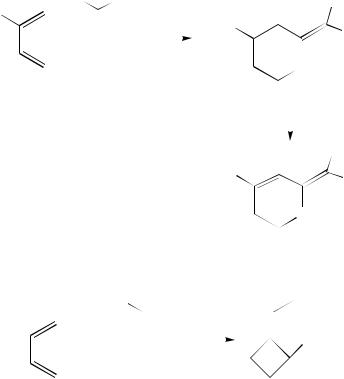
490 |
Gerhard V. Boyd |
The ketene 37 reacts with 2-methoxybutadiene to afford a 63% yield of the rearranged methylenedihydropyran 38 (equation 22)24. In contrast, dimethylketene and 1-methoxy- butadiene form a ‘normal cycloadduct’, the cyclobutanone 39 (equation 23)24.
Et |
|
|
|
Bu-n |
|
|
|
|
|
|
|
|
|
Et |
|
|
||
MeO |
|
|
|
|
|
|
|
|
|
MeO |
|
|||||||
|
|
|
|
|
|
|
|
|
|
|||||||||
|
|
|
|
|
|
|
|
|
|
|
||||||||
+ |
|
• |
|
|
|
|
|
|
|
|
|
|
|
|
|
Bu-n |
|
|
|
|
|||||||||||||||||
|
|
|
|
|
|
|||||||||||||
|
|
|
|
|
|
|
|
|
|
|
|
|
|
|
|
|
|
|
O |
|
|
|
|
|
|
|
|
|
O |
|
|||||||
|
|
|
|
|
|
|
|
|
|
|||||||||
|
|
|
|
|
|
|
|
|
|
|
|
|
|
|
|
|
||
(37) |
|
|
|
|
|
|
|
|
|
|
|
|
|
|
||||
|
|
|
|
|
|
|
|
|
|
|
|
|||||||
|
|
|
|
|
|
|
|
|
|
|
|
|||||||
|
|
|
|
|
|
|
|
|
|
|
|
(22) |
||||||
|
|
|
|
|
|
|
|
|
|
|
|
|
|
|
|
Et |
||
|
|
|
|
|
|
|
|
|
|
|
|
|
|
|
|
|||
|
|
|
|
|
|
|
|
|
|
MeO |
||||||||
|
|
|
|
|
|
|
|
|
|
|
|
|
|
|
|
Bu-n |
||
|
|
|
|
|
|
|
|
|
|
|
|
|
|
|
|
O |
||
|
|
|
|
|
|
|
(38) |
|
|
|||||||||
|
|
|
|
|
|
|
|
|
|
|
|
|
|
|
OMe |
|||
OMe |
|
|
|
Me |
Me |
|||||||||||||
|
|
|
|
|||||||||||||||
+ |
|
|
|
|
|
|
|
|
|
|
|
|
|
|
|
Me |
||
|
|
|
|
• |
|
|
|
|
|
|
|
|
|
|
||||
|
|
|
|
|
|
|
|
|
|
|
|
|
|
|||||
|
|
|
|
|
|
|
|
|
|
|
|
|
|
|||||
|
|
|
|
|
|
|
(23) |
|||||||||||
|
|
|
|
O |
|
|
|
|
|
|
|
|
|
Me |
||||
|
|
|
|
|
|
|
|
|
|
|
|
|
|
|
|
|||
|
|
|
|
|
|
|
|
|
|
|
|
|
|
|
|
|||
|
|
|
|
|
|
|
|
|
|
|
|
|
|
|
|
|||
|
|
|
|
|
|
|
|
|
|
|
|
|
O |
|||||
|
|
|
|
|
|
|
(39) |
|
|
|||||||||
III. ADDITION TO C=S COMPOUNDS
Thiocarbonyl compounds are more reactive dienophiles than their carbonyl counterparts.
Thioketones, such as thiofluorenone, hexafluorothioacetone and perfluorocyclobutanone, add to a variety of 1,3-dienes to give dihydrothiapyrans (e.g. equation 24)25. Styrene yields a 1 : 2 adduct with hexafluorothioacetone (equation 25)25. The reactions of thioacetophenone and thiobenzophenone with isoprene and 2-chlorobutadiene yield mixtures of regioisomers in quantitative yields (e.g. equation 26)26.
